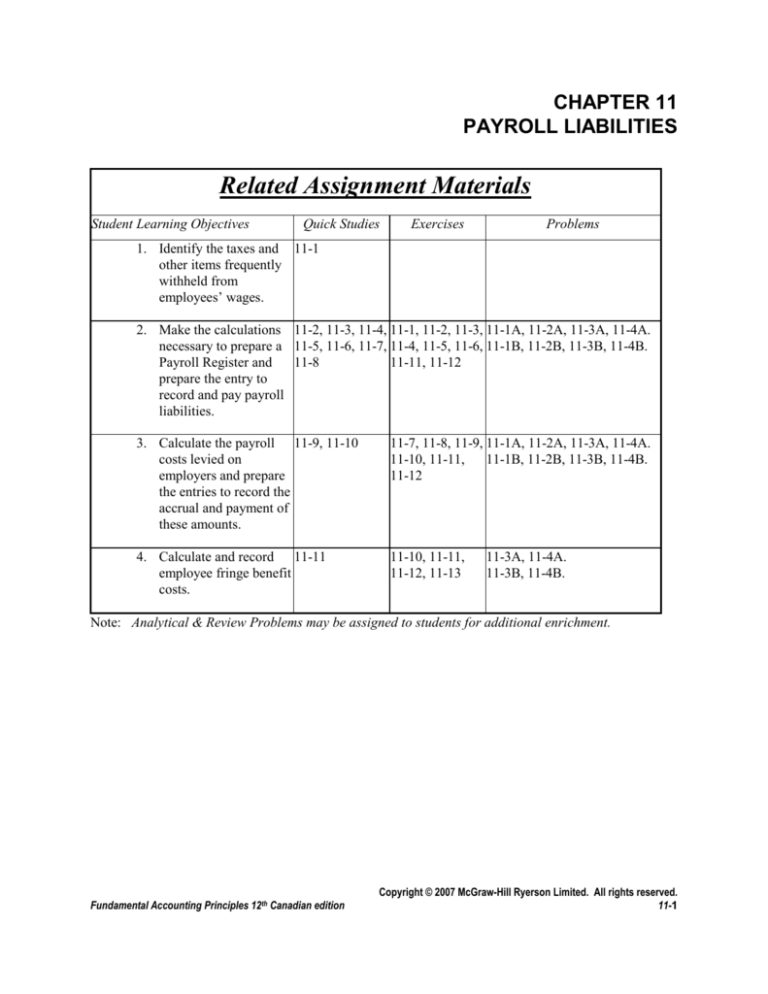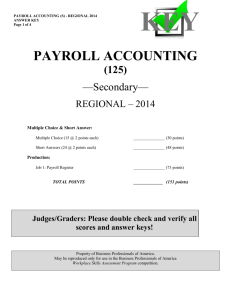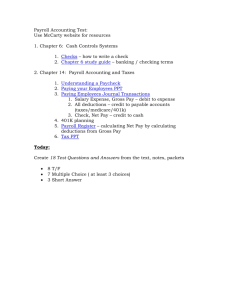
CHAPTER 11
PAYROLL LIABILITIES
Related Assignment Materials
Student Learning Objectives
Quick Studies
Exercises
Problems
1. Identify the taxes and 11-1
other items frequently
withheld from
employees’ wages.
2. Make the calculations 11-2, 11-3, 11-4, 11-1, 11-2, 11-3, 11-1A, 11-2A, 11-3A, 11-4A.
necessary to prepare a 11-5, 11-6, 11-7, 11-4, 11-5, 11-6, 11-1B, 11-2B, 11-3B, 11-4B.
Payroll Register and
11-8
11-11, 11-12
prepare the entry to
record and pay payroll
liabilities.
3. Calculate the payroll 11-9, 11-10
costs levied on
employers and prepare
the entries to record the
accrual and payment of
these amounts.
11-7, 11-8, 11-9, 11-1A, 11-2A, 11-3A, 11-4A.
11-10, 11-11,
11-1B, 11-2B, 11-3B, 11-4B.
11-12
4. Calculate and record 11-11
employee fringe benefit
costs.
11-10, 11-11,
11-12, 11-13
11-3A, 11-4A.
11-3B, 11-4B.
Note: Analytical & Review Problems may be assigned to students for additional enrichment.
Fundamental Accounting Principles 12th Canadian edition
Copyright © 2007 McGraw-Hill Ryerson Limited. All rights reserved.
11-1
Instructor’s Notes
Chapter Outline
For most business labour cost represents a significant proportion of total
expenses and consequently materially affects net income. Payroll accounting:
Records cash payments to employees
Provides valuable information regarding labour costs.
Accounts for amounts withheld from employees’ pay.
Accounts for employee (fringe) benefits and payroll costs paid by the
employer.
Provides the means to comply with government regulations on
employee compensation.
I.
Items Withheld from Employees Wages
A. Employee Income Taxes
1. The first federal income tax law became effective in 1917
applying to only a few individuals. During World War II
income taxes were levied on substantially all wage earners.
The income tax system continues to evolve and is affected
yearly by government budgets.
2. Employers are required to withhold a portion of their
employees' gross earnings for payment to the Receiver
General of Canada. The amount withheld should
approximately equal the employees' tax liability at year-end.
3. Each employee must file an Employee Tax Deduction
Return (TD1) indicating the amount of exemptions claimed.
Employers withhold taxes on the bases of information
provided on this TD1 form.
4. CRA provides tax withholding tables to determine the
exact amount to withhold based on completed TD1 forms.
5. With the exemption of Quebec, taxes withheld include
provincial taxes. Tax withholding tables will differ among
provinces to reflect different provincial rates.
B. Canada Pension Plan
1. Applies to all employees and self-employed individuals
between the ages of 18 and 70. (few exceptions)
2. Employers must withhold the employee contributions and
remit these deductions to the Receiver General of Canada.
Quebec, however, administers its own similar pension plan.
Copyright © 2007 McGraw-Hill Ryerson Limited. All rights reserved.
11-2
Fundamental Accounting Principles 12th Canadian edition
Instructor’s Notes
Chapter Outline
3. Employers must match the employee contribution and
remit an equal amount to the Receiver General of Canada.
4. Self-employed individuals must pay the combined rate for
employees and employers of 9.9% of annual earnings between
$3,500 and $42,100.
C. Employment Insurance Program (EI)
The objectives of the EI program are: To alleviate financial
hardships caused by interruptions in employment earnings.
EI is financed jointly by employees and their employers.
Employers are required to deduct 1.87% from employees'
gross wages (the definition of insurable earnings for use in
this text). The employer must then contribute 1.4 times the
employee contribution. Both the premium rate and the
insurable earnings may change yearly at government
discretion.
The Employment Insurance Act requires an employer to
complete a “Record of Employment” because of termination
of employment, illness, injury or pregnancy and keep a record
for each employee showing wages subject to employment
insurance and taxes withheld.
Use of Withholding Tables--Tables are available in paper and
electronic form which determine how much CPP, EI and taxes
should be deducted from employees. Employers are required to
prepare T4 forms for employees and forward them on or before
the last day of February each year.
Wages, Hours and Union Contracts—All provinces have laws
which specify minimum pay rates and establish maximum hours
of work. Businesses must pay an overtime premium for hours in
excess of 40 per week, i.e., time and a half (1 1/2 times regular
rate). Union contracts that promise better benefits take precedence
over provincial legislation, i.e., double time or double time and a
half for holidays.
D. Other Payroll Deductions
Individual employees may authorize additional deduction of
specific amounts.
Examples Include:
1. purchase of Canada Savings Bonds
2. insurance premium (health, accident, life, hospital)
3. loan repayments (loan from employer or employee’s
credit union)
4. deductions to pay for merchandise purchased from the
company
5. charitable donations (United Way, Red Cross)
Fundamental Accounting Principles 12th Canadian edition
Copyright © 2007 McGraw-Hill Ryerson Limited. All rights reserved.
11-3
Instructor’s Notes
Chapter Outline
II.
Payroll Register
The total hours worked by each employee are summarized in a Payroll
Register. Gross pay, which includes regular hours plus any overtime
premium is calculated first. Deductions, such as CPP, EI, income
taxes and net pay are summarized by pay period in payroll register.
Columns are provided for employee name, hours worked, (regular and
overtime hours), earnings, each deduction, payment amount, cheque
number, salary expense, account debited. See text illustration 11-2. The
design of a payroll register is dependent on the needs of management and
the requirements of various payroll-related laws.
Recording the Payroll
The data in the payroll register is used for general journal entry.
Sales Salaries Expenses
XXX
Office Salaries Expense
XXX
Employment Insurance Payable
XXX
Employees' Income Taxes Payable
XXX
Employees' Hospital Insurance Payable
XXX
Canada Pension Plan Payable
XXX
Payroll Payable
XXX
XXX
XXX
XXX
XXX
To record the Payroll for the week ending (date).
The salaries and wages expense accounts are charged for the
gross wages since that is the cost to the employer. The fact
that the gross pay will be paid to the employee, the Receiver
General, insurance companies, etc. affects the current liability
accounts.
The Payroll Payable is the net amount due employees. The
payroll entry is usually made at the end of a payroll period. A
time lag exists between the end of a payroll period and the
payday.
The payroll register, instead of the general journal, could
serve as a journal and the payroll data could be posted to the
ledger accounts from the payroll register.
Paying the Employees
Almost every business pays employees by cheque or through
electronic funds transfer. Employees are given an earnings
statement each payday.
Copyright © 2007 McGraw-Hill Ryerson Limited. All rights reserved.
11-4
Fundamental Accounting Principles 12th Canadian edition
Instructor’s Notes
Chapter Outline
Employee's Individual Earnings Record
An individual record for each employee (see illustration 11-5)
accumulates information that:
a. serves as a basis for employer payroll tax returns.
b. indicates when an employee's cumulative gross earnings
have reached ceilings for CPP and EI deductions
c. supplies data for Form T-4, which must be given to each
employee at year-end. (see exhibit 11-1.)
III.
Payroll Deductions Required of the Employer
The employer is required to pay an amount equal to the sum of
employees’ CPP and 140% of employees EI to CCRA on behalf of
employees.
The general journal entry to record the employer's amounts is
EI Expense (1.4X employees’ amt.) XX
CPP Expense (same as employees’)
EI Payable
CPP Payable
XX
XX
XX
These amounts along with employees’ deductions are remitted to the
Receiver General. This payment is usually done by the 15th of the
next month.
Fundamental Accounting Principles 12th Canadian edition
Copyright © 2007 McGraw-Hill Ryerson Limited. All rights reserved.
11-5
Instructor’s Notes
Chapter Outline
IV.
Employee Benefit Costs
Fringe benefits include insurance and retirement plans.
1. Workers compensation and vacation pay are required to be paid by
employers according to legislation in each province.
2. Employers that pay for part or all of these benefits incur payrollrelated expenses.
a. Benefits Expense
XXX
b. Employees' Hospital Insurance Payable.
XXX
c. Employees' Retirement Program Payable
XXX
XXX
XX
Note: Students should be made aware of the business reality that the cost
of employing an individual is far greater than the annual salary. Payroll
taxes and fringe benefits can add well over 25 percent to the salaries.
3. Vacation Pay
The effect of a two-week vacation is to increase the employer's
payroll expense by 4% (2 weeks/50 weeks). The fact that some
employees do not accrue vacation time until they have worked for
a certain period of time reduces this percentage.
Benefits Expense
XXX
Estimated Vacation Pay Liability XXX
As employees take their vacation, the estimated vacation pay
liability is reduced. All deductions are applicable to vacation pay.
Copyright © 2007 McGraw-Hill Ryerson Limited. All rights reserved.
11-6
Fundamental Accounting Principles 12th Canadian edition





